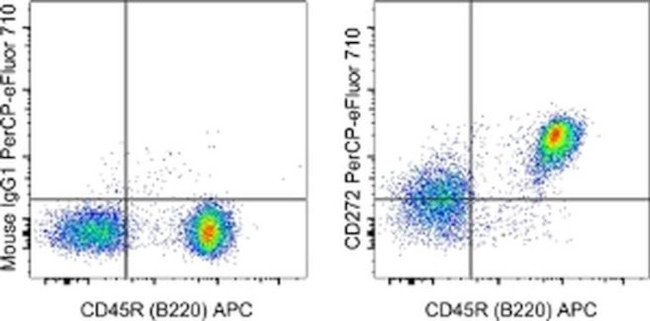Search Thermo Fisher Scientific
Invitrogen
CD272 (BTLA) Monoclonal Antibody (6F7), PerCP-eFluor™ 710, eBioscience™
FIGURE: 1 / 1
CD272 (BTLA) Antibody (46-5950-82) in Flow

Product Details
46-5950-82
Species Reactivity
Host/Isotype
Recommended Isotype Control
Class
Type
Clone
Conjugate
Excitation/Emission Max
Form
Concentration
Purification
Storage buffer
Contains
Storage conditions
Shipping conditions
RRID
Product Specific Information
Description: The BTLA antibody reacts with mouse BTLA, B and T lymphocyte attenuator. BTLA is expressed by peripheral lymphocytes, splenic macrophages, developing B cells in the bone marrow and developing T cells in the thymus and mature, but not immature bone marrow-derived dendritic cells. BTLA has been implicated as a negative regulator of the activation and/or function of various hemopoietic cell types. It is reported that BTLA binds to B7-H4, but further studies are needed to confirm this interaction.
Note: The anti-mouse BTLA monoclonal antibody 6F7 is reported to stain CD4^+ and CD8^+ single-positive (SP) thymocytes (Hurchla et al). However, other anti-mouse BTLA clones generated simultaneously with 6F7 (8F4, 3F9.D12, 6G3 and 6H6) do not stain SP thymocytes. It is not understood why there is a discrepancy in thymocyte staining however clones 8F4, 3F9.D12, 6G3 and 6H6 stain similar populations to 6F7 in splenocytes and bone marrow cells.
Applications Reported: This 6F7 antibody has been reported for use in flow cytometric analysis.
Applications Tested: This 6F7 antibody has been tested by flow cytometric analysis of mouse splenocytes. This can be used at less than or equal to 0.125 µg per test. A test is defined as the amount (µg) of antibody that will stain a cell sample in a final volume of 100 µL. Cell number should be determined empirically but can range from 10^5 to 10^8 cells/test. It is recommended that the antibody be carefully titrated for optimal performance in the assay of interest.
PerCP-eFluor® 710 emits at 710 nm and is excited with the blue laser (488 nm); it can be used in place of PerCP-Cyanine5.5. We recommend using a 710/50 bandpass filter, however, the 695/40 bandpass filter is an acceptable alternative. Please make sure that your instrument is capable of detecting this fluorochrome.
Light sensitivity: This tandem dye is sensitive to photo-induced oxidation. Please protect this vial and stained samples from light.
Fixation: Samples can be stored in IC Fixation Buffer (Product # 00-8222) (100 µL of cell sample + 100 µL of IC Fixation Buffer) or 1-step Fix/Lyse Solution (Product # 00-5333) for up to 3 days in the dark at 4°C with minimal impact on brightness and FRET efficiency/compensation. Some generalizations regarding fluorophore performance after fixation can be made, but clone specific performance should be determined empirically.
Excitation: 488 nm; Emission: 710 nm; Laser: Blue Laser.
Filtration: 0.2 µm post-manufacturing filtered.
Target Information
BTLA or B and T-lymphocyte attenuator is a member of the co-inhibitory receptors of the CD28 superfamily. BTLA is a lymphocyte inhibitory receptor which inhibits lymphocytes during immunes responses. BTLA is constitutively expressed on most CD4+ and CD8+ T cells and its expression progressively decreases upon T cell activation. It remains expressed on Th1 cells, but not Th2 cells. BTLA is a unique co-receptor that interacts with the tumor necrosis factor receptor superfamily member herpesvirus entry mediator (HVEM). This interation is an important pathway regulating lymphocyte activation and/or homeostasis in the immune response.
For Research Use Only. Not for use in diagnostic procedures. Not for resale without express authorization.
How to use the Panel Builder
Watch the video to learn how to use the Invitrogen Flow Cytometry Panel Builder to build your next flow cytometry panel in 5 easy steps.
References (0)
Bioinformatics
Protein Aliases: B and T lymphocyte associated protein; B and T lymphocyte attenuator; B- and T-lymphocyte attenuator; B- and T-lymphocyte-associated protein; BTLA_HUMAN; CD272; CD272 antigen; FLJ16065; MGC129743
Gene Aliases: A630002H24; Btla
UniProt ID: (Mouse) Q7TSA3
Entrez Gene ID: (Mouse) 208154

Performance Guarantee
If an Invitrogen™ antibody doesn't perform as described on our website or datasheet,we'll replace the product at no cost to you, or provide you with a credit for a future purchase.*
Learn more
We're here to help
Get expert recommendations for common problems or connect directly with an on staff expert for technical assistance related to applications, equipment and general product use.
Contact tech support

